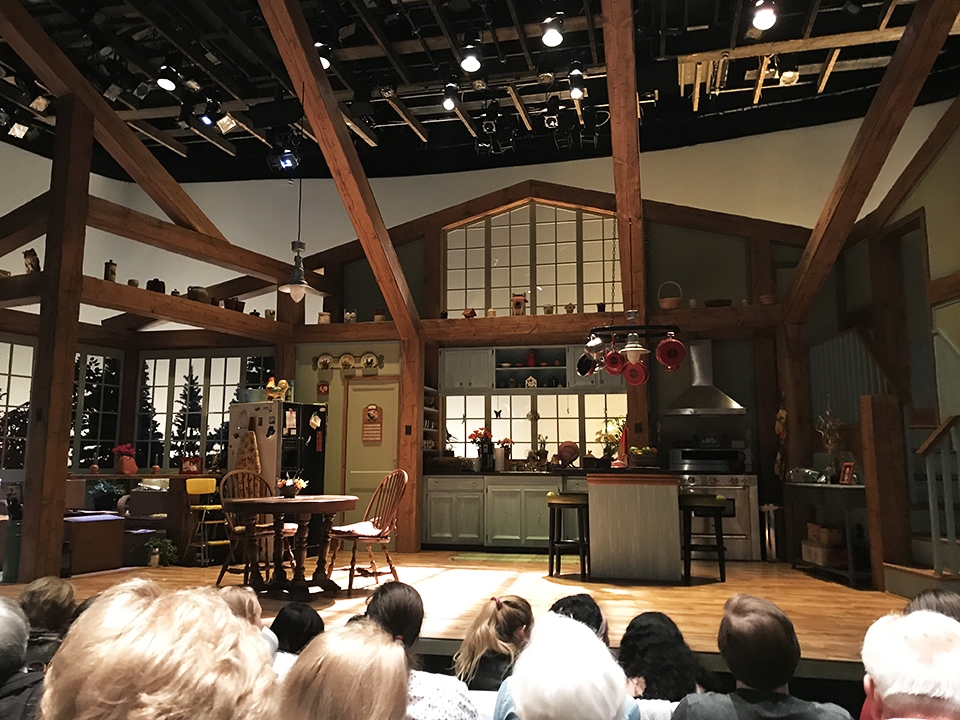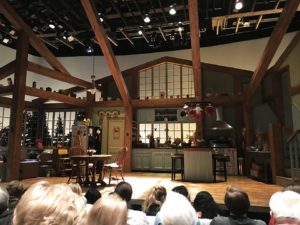

The set for The Roommate by Jen Silverman, described by the program as “a big old house in Iowa City.”
Griffin Sendek | Features Editor
03/27/19
The moment I took my seat in the City Theater for the performance of The Roommate, I was utterly dumbfounded at how immaculate and expertly-crafted the set was.
The set for the show was meant to replicate the look of an Iowa home, and designer Tony Ferrieri could not have done a better job creating that homely Midwestern feel. The longer I was able to look at the stage, the more details I found. There was the assorted pottery lining the wooden beams, picture frames next to the stairs, pots and pans hanging from a chandelier, refrigerator magnets, plants behind the sink and a gigantic window dominating the back wall.
The list could go on and on; every prop and piece of set dressing was deliberately chosen to help further the particular tone and mood of the setting and serve as a window into the life of the character that lived in the house.
The craftsmanship involved in bringing this set to life is some of the best I have ever seen, in line with some of the scenic design found on Broadway. Not a single detail was missed; had it not been for the light fixtures hanging above, I would have believed someone could actually live there.
This all went through my head before the play even began. I was more than excited to find out if the play itself could match the quality of the set it took place on.
The Roommate, written by Jen Silverman, tells the story of Sharon (Tamara Tunie), a woman in her 50s, now divorced and who put an ad out for a roommate to help fill her big house in Iowa City. The play opens with Robyn (Laurie Klatscher), a woman from the Bronx that is about as different from Sharon as can be, moving in and slowly getting to know one other.
At the opening of the show, the odd couple dynamic between Sharon and Robyn is entertaining and hilarious. The skillful writing of the show is brought to the forefront as both characters share a very awkward introduction to one another.
Early on, Tunie said her lines in a fashion that exaggerated how uncomfortable the situation between her and her new roommate was. I understood what she was going for with her line delivery, but it made the dialogue feel awfully stunted and unnatural, which overall hurt my early impressions of the show. I had a similar feeling with Klatscher’s line delivery, but it was nowhere near as noticeable or distracting as her scene partner.
These opening scenes are an example of how far good writing can help carry a show when the acting isn’t at its perfection. For every moment that the performances took me slightly out of the show, the fantastic and absolutely hilarious writing dragged me right back in.
Already not fully enjoying one member of the two-person cast, I was a little worried for the rest of the 100-minute run of The Roommate. But as the show continued and the characters got closer and more comfortable with one another the stilted, awkward dialogue lifted. The full extent of Tunie and Klatscher wonderful acting abilities are featured in all their glory.
Phone calls are central to the story of The Roommate, and every moment a character picks up a phone is excellently done. The person on the other end of the line is never heard, but the audience can still fully understand the conversation without a second of confusion. As the story unfolds, it is revealed that Robyn isn’t exactly who she said she was, and is escaping a life of crime. In a desire to have a little more excitement in her life, Sharon begs Robyn to teach her some of her ways, which creates one of my favorite scenes in the entire play. Robyn teaches Sharon how to run a phone scam in the most comical fashion, that is as well a masterful combination of writing, acting and staging.
Director Reginald L. Douglas utilized the entirety of the large stage, effectively filling the space with only two people. Never once when watching the show did I witness any movement that felt unmotivated or out of place. Everything that happened in the show felt completely natural as if they were really two people that shared the house. Douglas’s work and commitment to making this show the best it could be was present in every facet of the production.
Behind the set was a cyc (a large white curtain that changes color based on the lights shined upon it) that transitioned in color to convey the different times of day. The cyc was best utilized during nighttime scenes where the dark blue shade of light can be seen through the large on set windows. A full blackout was only used once near the end of the show, with the purpose of going completely dark, only to shine warm orange lights through the side window replicating the look of a sunrise. With the shadows from the windows slowly making their way across the stage as the light moved, it was one of the most beautiful, almost cinematic, depictions of a sunrise on stage that I have ever seen.
The Roommate did not go crazy with its lighting, focusing more on the story between two women, but when lighting designer Andrew David Ostrowski was able to let his creative juices flow, he produced some truly breathtaking sites.
All in all, The Roommate was a fantastic piece of theater that I thoroughly enjoyed, and laughed all the way through. The bumpy start had me worried, but it more than redeemed itself in the end. Everyone involved in this production should be proud of the work they produced. In the future, I am looking forward to seeing more plays from the creative minds at City Theater.


